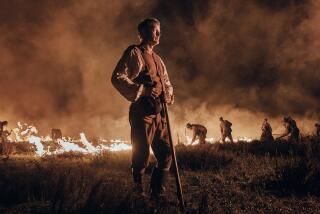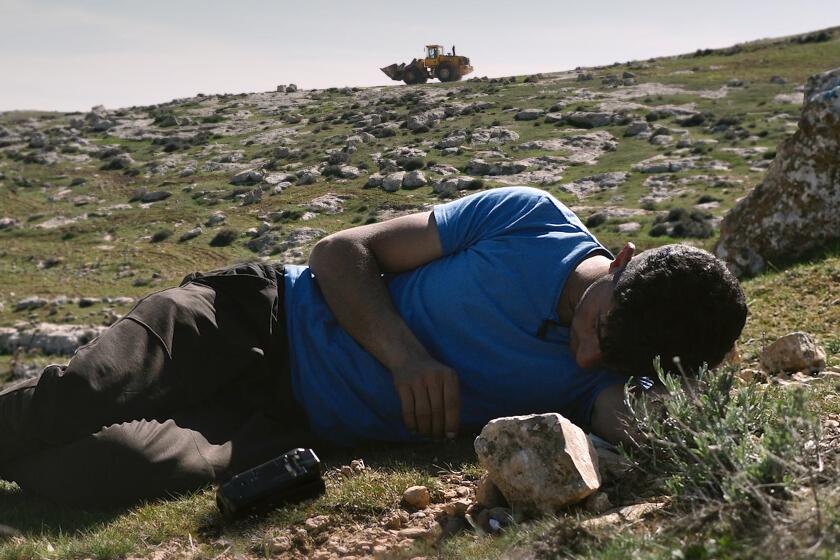Review: Mads Brügger’s bold, unruly documentary ‘Cold Case Hammarskjöld’ investigates the death of a diplomat
- Share via
On Sept. 18, 1961, a Douglas DC-6 crashed near the city of Ndola, Northern Rhodesia (now Zambia), killing all 16 people on board. Among them was the United Nations secretary-general, Dag Hammarskjöld, a fierce proponent of African autonomy and decolonization who had been on his way to settle a conflict in the Congolese province of Katanga. The tragedy immediately spurred rumors of foul play, with some speculating the plane had been sabotaged by Belgian mining interests, South African paramilitary forces and/or other parties bent on maintaining the colonialist status quo.
Hammarskjöld’s death is one of many unsolved mysteries in “Cold Case Hammarskjöld,” a twisty, thorny new documentary that grips, jolts and exasperates in roughly equal measure. It’s the latest work from Mads Brügger, a Danish filmmaker with Michael Moore’s knack for confrontation and some of his countryman Lars von Trier’s impishness. Starting with “The Red Chapel,” his 2010 peek behind the walls of present-day North Korea, he has carved out a lively if murky nonfiction niche for himself: He delights in storming into conflict zones and playing both the dogged muckraker and the self-aggrandizing showman.
This is not the first time Brügger has taken up a camera — or stepped in front of it — to expose political and financial corruption on the African continent, as he did in 2011’s “The Ambassador.” Nor is it the first time he has so brazenly (and, it must be said, entertainingly) blurred the lines between investigation and provocation, personal memoir and geopolitical thriller. In “Cold Case Hammarskjöld,” he seems to take particular relish in both exploiting and undermining the conventions of the detective procedural. As he tracks down witnesses and pores over old documents and photographs, he narrates and theorizes up a storm, annotating and interrogating his own unruly process at every turn.
His collaborator in that process is a Swedish aid worker named Göran Björkdahl, who has spent years investigating the case and possesses a hole-riddled metal plate, acquired by his father during a 1975 visit to the crash site, that may or may not have broken off from the DC-6. Was the plane shot down? Was a bomb planted on board during the hours it was left unguarded? Brügger and Björkdahl seek answers in Ndola, where several eyewitnesses seem to contradict the official determination that the crash was due to pilot error.
From there, Brügger leaps to a trove of documents that emerged in 1998 during meetings of the South African Truth and Reconciliation Commission after the end of apartheid. The documents strongly suggested that Hammarskjöld’s death had been masterminded by the South African Institute for Maritime Research, a sinister-sounding paramilitary organization said to have promoted the cause of white supremacy in Africa. Whether SAIMR really existed, or still exists, is a question left hanging for much of the movie. But the deeper Brügger digs, the more troubling and damning the trail seems to become.
There are persistent rumors of a plot to weaponize the AIDS virus and infect and wipe out black Africans en masse. Other suspicious deaths are revisited, including the 1990 killing of Dagmar Feil, a marine biologist who did research for SAIMR. The number of methods by which the plane might have been brought down seems to multiply by the minute, as does the number of possible participants, from a Belgian pilot to American and British intelligence operatives. At the center of it all is Keith Maxwell, the “commodore” of SAIMR and the author of a fictionalized memoir — excerpts of which are visualized here through black-and-white animation — that offers another distorted lens through which to view the events in question.
Trustworthy or not, these discoveries have an undeniable fascination, which makes it all the more curious that Brügger sometimes undermines them with humorous, stunt-like asides. At one point he obtains (but then loses) permission to dig up wreckage from the crash site, though he seems less excited by the likelihood of finding anything new than he is by the prospect of operating a metal detector and wearing a white pith helmet. That choice of headgear, a cringe-inducing throwback to decades of European colonialism, is not the only instance in which the filmmaker seems to be enjoying the expedition for questionable reasons.
The documentary is structured around initially bewildering scenes of Brügger in a hotel room, dictating information to one of two women, Clarinah Mfengo and Saphir Wenzi Mabanza. They serve as sounding boards for Brügger and surrogates for the audience: When the director warns one of them that “in theory, all of this could be an elaborate hoax,” he seems to be both preempting our criticisms and encouraging us to stick with this difficult, complicated story.
But Mfengo and Mabanza also function as necessary stand-ins for their own curiously underrepresented people. The recurring sight of two black African women taking dictation from a white European man becomes a loaded metaphor, a means of “visualizing colonialism and racial relations in Africa,” as Brügger himself notes in the movie’s production materials. It’s an intriguing gambit in a documentary that examines the history of colonial and post-colonial Africa without specifically foregrounding the experiences of black African people — a discrepancy that some critics also saw and called out in “The Ambassador.”
In that context, it’s fair to wonder if his choice of framing device here smacks of bad-faith tokenism, wily self-critique or a strange combination of both. But as “Cold Case Hammarskjöld” keeps building and dismantling its own arguments, unraveling yet more conspiracies tucked inside conspiracies, Brügger’s gimmickry recedes and the puzzle begins to come together almost in spite of itself. The filmmaker’s logical leaps and temporal digressions, disorienting as they are at first, feel like honest attempts to define the story’s parameters, illuminating the contours of a plot that spreads out wildly in all directions.
And Brügger’s mischievous streak is increasingly checked, and ultimately neutralized, by the undeniable horror and moral gravity of what he uncovers. The question of who killed Hammarskjöld may never be resolved, but the movie does arrive, by way of some crucial, revelatory testimony, at a different answer of sorts — a glimpse of a vast and deadly conspiracy whose victims outnumber one heroic diplomat and whose patterns of greed, racism and violence seem to recur with ruthless inevitability through human history. You may not leave this movie satisfied, but you will be appalled — and chilled to the bone.
------------
‘Cold Case Hammarskjöld’
Not rated
In English, French, Bemba, Swedish and Danish with English subtitles
Running time: 2 hours, 4 minutes
Playing: Alamo Drafthouse Cinema Downtown Los Angeles and Laemmle Monica Film Center, Santa Monica
More to Read
Only good movies
Get the Indie Focus newsletter, Mark Olsen's weekly guide to the world of cinema.
You may occasionally receive promotional content from the Los Angeles Times.











